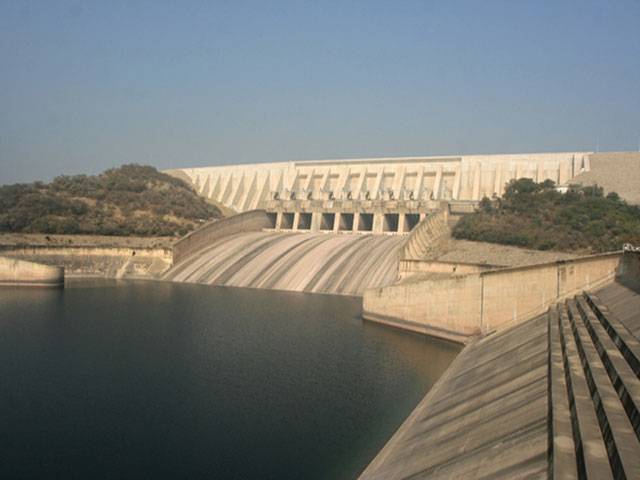LAHORE - Pakistan will face trickle down effect for not constructing water reservoirs including the Kala Bagh Dam as the water storage in Mangla and Tarbela will end on 18th of this month, TheNation has learnt.
If more water reservoirs were not constructed in near future, the water and food experts warn, Pakistan may face the fate of Ethiopia and other such famine-hit African countries.
Sources in the Irrigation Department disclosed that the Indus River System Authority (IRSA) from Ist January 2014 onwards to March 10 faced 21pc low flow in the rivers that not only halted the storage as well as the power generation on the dams. As per details, the flow in Indus River 13pc less, in Kabul River 18pc less, Chenab River 8pc and Jhelum 7pc. It was also told that the IRSA estimated 7pc less flow in the rivers from October to March for the Rabi season. Last year on 10th March, the dams had 1.485 MAF storage but this year it reduced to 0.718 MAF, which the experts say was much alarming. The dream of filling total water storage capacity of all the three major reservoirs including Mangla, Tarbela and Chashma that is 14.262 MAF will never be materialised given the current flow in the rivers. The total demand of irrigated water for all the provinces in 2013-14 was estimated as 37 MAF.
If the country faces less rain fall, the situation may worsen in the coming months that would badly affect the sowing of kharif crop, the water experts warn. The shortage will be on the peak when sowing the kharif crop starts in April; they said and added that the system faces severe shortage of 15pc for the Rabi season.
All the provinces got less shares in water distribution. As per data Punjab got 16.28 MAF against 18.78 MAF, Sindh 12.5 MAF against 14 MAF.
As per the 1991 water distribution pact among the provinces, the share of Punjab for Rabi season is 18.78 MAF, share of Sindh 14 MAF, KPK 0.8 MAF and that of Balochistan is 1.03 MAF. As per reports, the water surface of Tarbela is 22 feet but that of Mangla is 42 feet up than the dead level.
The water entering at Tarbela was recorded as 10500 cusecs and spill was 45000 cusecs and the water level in the dam was 1401.50 feet against the dead level of 1378 feet of the dam and it contains 0.293 MAF. On the other hand, at Mangla, arrival of water was recorded as 15400 and fall was 32000 cusecs. The water level at the dam was 1083.60 feet and storage is 0.406 MAF but its dead level is 1040 feet. The water flow in Chenab at Marala was recorded 9500 cusecs and in Kabul River the flow at Noshera was 6200 cusecs.
When contacted Irrigation Department consultant Mehmoodul Hasan Siddiqui confirmed that the system might witness 15pc water shortage for irrigation purposes. He said that the dams would be empty if there were no rain falls. He said that the country would face severe shortage of water for irrigation as well as power production at dams. He said as the country’s high birth rate is producing additional millions of people each year and the current situation would further place further strain on a population already vulnerable to water insecurity.
The only solution of the current precarious situation was construction of new reservoirs.
An officer of the Punjab Irrigation department said that Pakistan is among the 17 countries of the world that might face severe shortage of water by 2025. He said that the developing countries were planning to treat the used water but we lacked any planning to store water. To meet the needs, Pakistan needs to invest fast in increasing storage capacity in a sustainable way to avoid irrigation and energy problems. Pointing towards over 150 Thar killings in the Sindh, he said, if no new dams were constructed the situation would be the worst.
Sunday, May 19, 2024
Mangla, Tarbela to hit dead level on 18th

Caption: Mangla, Tarbela to hit dead level on 18th
Ishaq Dar’s Kyrgyzstan visit ‘cancelled’
12:59 PM | May 19, 2024
Polling underway for by-election in NA-148 Multan-1
11:05 AM | May 19, 2024
CM lays foundation stone of Nawaz Sharif IT City in Lahore
11:04 AM | May 19, 2024
‘Open courts being held to solve people’s problems’
May 19, 2024
MCL removes encroachments
May 19, 2024
NEPRA’s Neglect
May 19, 2024
Colonial Grip
May 19, 2024
Confrontational Politics
May 19, 2024
Sports & Genocide
May 18, 2024
Healing AJK
May 18, 2024
Unsung Heroes of Society
May 19, 2024
Water Shortage in Our Area
May 19, 2024
The AI Trap
May 19, 2024
Continuing Narrative of Nakba
May 18, 2024
Teacher Struggles
May 18, 2024
ePaper - Nawaiwaqt
Advertisement
Nawaiwaqt Group | Copyright © 2024





